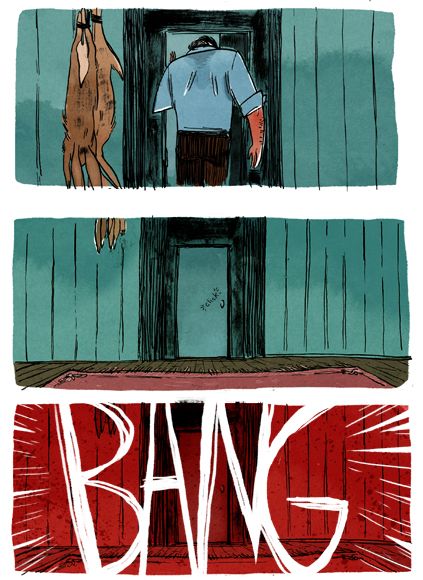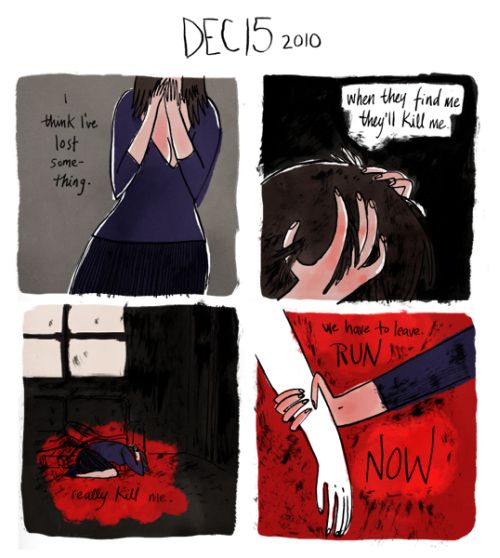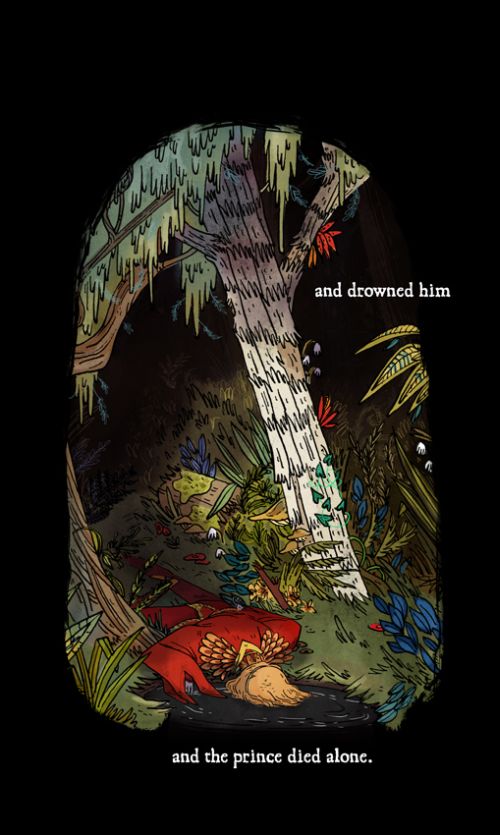In late 2010, it seemed like Emily Carroll sprang to the forefront of the webcomics “scene” (if such a thing can even be said to exist, considering the massive, diverse community of artists producing and distributing work online) out of nowhere, a creator with a fully-formed style and aesthetic, producing eerie horror/fantasy comics that resonate beautifully as something unique among the myriad autobio, slice-of-life, and parody strips that proliferate within the format. Specifically, the story “His Face All Red” was what seemed to grab the attention of many, released in a perfectly-timed moment around the scare-celebrating Halloween holiday. This story revealed a bright, exciting talent in possession of a lovely grasp of often-spooky mood, an ability to communicate emotions like guilt and dread through deceptively simple character artwork, perfect control over time and pacing, and a gorgeous color sense. It’s rare to see an artist so in control of their abilities, telling exactly the kinds of stories they want to tell, so Carroll’s sudden emergence was a definite treat for anyone lucky enough to recognize it.
As can be seen in the archive section of her site, Carroll had created a few other stories that year (and she had been posting art, often inspired by video games and works of sci-fi/fantasy, on her blog for some time previously), working her way up to the story that really caught her some attention. Of those, “The Death of Jose Arcadio” is an interesting experiment in web formatting, although I think its most effective moment comes with the sudden moment described in the title:
And the creepy little fables “The Hare’s Bride” and “Out the Door” are nice pieces that do interesting things with mood and pacing, allowing us to see as her skills were growing by leaps and bounds. I especially like how, in the latter, the scariest moment of a nighttime trip through a house full shadowy, candlelit hallways comes when the main character ventures past some brightly-lit windows in which some sort of unknown (alien?) activity is going on outside, emphasizing the otherworldly nature of the strange tale:
But, as mentioned, “His Face All Red” was the real moment of revelation. Carroll immediately establishes a sort of medieval setting, and a feeling of uneasiness, which the narrator, a blank-faced young man with dot-eyes and simplistic features reminiscent of Tintin, feels toward the man who seems to be his brother, but can’t be, since the young man killed his brother a few days ago. He describes how his brother was popular, confident, and brave, with a beautiful wife, a larger house, and the love of everybody in the town, unstated jealousy and resentment simmering under the surface, but easily seen in panels like this one:
When the two brothers venture into the sinister-seeming forest surrounding the town to hunt a beast that is killing the local livestock, circumstances lead to the aforementioned murder, but three days later, the brother wanders back into town, claiming to have gotten lost, and not mentioning anything about the circumstances behind his disappearance. Carroll allows the confused dread and guilt to build as the younger brother silently struggles to understand what’s going on, questioning who this impostor is, or if he is somehow incorrect about what happened. He eventually returns to the forest, lowering himself into the hole where he disposed of the body, and then the story ends abruptly and ambiguously, allowing the plot’s climax to take place in readers’ imaginations.
This is all fairly simple, but Carroll makes it work beautifully, using hand-written narration placed directly on top of the art, rather than sequestered in caption boxes, and delivered bluntly, like a story being hastily scrawled in a journal. The use of occasional parenthetical asides especially adds to that feeling, as well as the mood of unease surrounding the character, as when he mentions that the beast “came from the woods. (most strange things do)”. The pacing is also excellent, with each “page” of the story flowing vertically down the screen, panels sized and situated in a way that makes for an intuitive read, with some scenes playing out through panels placed horizontally adjacent to each other, and others conveying the passage of time by stacking wide panels on top of each other. The flow is sometimes halted by the placement of a small panel below a large, wide one, the extra black surrounding it making it stand out. And that black background itself makes the world of the story itself seem dark and dangerous around the edges, working in tandem with the deep shadows that obscure the details of the art. It also makes the colors stand out effectively, especially in the moments where death occurs out of the readers’ sight and the panel is bathed in bright red:
Other details enhance the mood of the story, like the description and depiction of “a tree with leaves that looked like ladies’ hands,” or the way the young man’s descent into the hole becomes a vertical scroll down the screen, but I especially like the way the depiction of the returned “brother” is limited to the lower half of his face or the back of his head, making him seem somehow inhuman, even though his celebrations should be natural expressions of joy. It’s as if Carroll has placed us in the head of her emotionless protagonist, with dark shadows and blackness encroaching from all sides, and even happiness seeming alien and incomprehensible. It’s a scary place to be, and a demonstration of her control over the emotions evoked in her comics.
Having announced herself so well, Carroll produced a few more good pieces over the next year, including a series of dream journal comics that limited themselves to four panels each that focus on a brief moment or feeling, a different approach than the sort of collection of weird details and non-sequitur-filled narratives that dream comics usually take. The best of these act as miniature horror comics, providing a glimpse of what could be a longer story, but even though we don’t know the details, we still are thrust into the main character’s head in a way that brings the emotions right to life:
It’s like a dry run for longer stories, and one of the better answers I’ve ever seen to the usually tiresome question of where writers get their ideas.
“The Prince and the Sea” is another good little story from this period, taking the form of a romantic poem about a prince falling in love with a mermaid that plays out against a static background, before taking a turn to the tragicomic/horrific in the end (and using the online reading experience as a benefit as well, with a journey to the sea’s depths becoming a drifting descent down the screen). I especially like the depiction of the mermaid, which seems to take inspiration from early-20th-century artists like Nell Brinkley:
And the death of the prince provides a nice bit of Edward Gorey-style deadpan morbidity:
As nice as stories like that are, what I consider to be Carroll’s masterpiece (at least as of this writing) came in Halloween of 2011, with the story “Margot’s Room”, which was serialized throughout the month of October. It’s another dark horror tale, and another example of innovative use of the webcomics format. The title page consists of a portentous image of a dark room, rain pouring in through an open window and blood smeared on a bed and across the floor, with a poem whose lines provide hints at where one should click within the image to read each chapter of the story. The chapters start out normal enough, although tinged with sadness from the start, as the main character, a young woman, meets her future husband while mourning at her father’s funeral. As with “His Face All Red”, a medieval setting is quickly established, mostly through costume choices, but the relationship between the couple is also filled in remarkably efficiently, with an exchange about funerals demonstrating their relative outlooks on life and providing them with believably warm, loving relationship:
That chapter does contain some ominous forbodeing, and not just because it takes place at a funeral, but the second chapter wastes no time in plunging right into despair, as we jump forward several years, only to learn that the couple had a daughter, the Margot of the title, but she died of an unspecified illness, and there has been a rift between them ever since. This chapter switches from vertical to horizontal scrolling, which somehow makes the transitions from panel to panel seem more slow and excruciating, drawing out the anguish the characters feel:
The following chapters serve as a slow dissolution of the couple’s relationship, but this being a horror comic, Carroll turns a sad domestic disagreement into a scary, supernatural conflict, starting when the husband disappears on a trip, then returns with a story about wandering into some hidden forest clearing, and waking up somewhere else. As a metaphor for alcoholism (or something similar), his eventual transformation into something inhuman works quite well, and it leads to a harrowing, gory final chapter that brings us back to that ominous opening image, explaining everything and providing lingering horror both physical and emotional.
It’s an amazingly effective tale, with a darkness that hits home through its manipulation of emotions, a sense of dread building throughout, even as tragic sadness suffuses every panel all the way through that awful final scene. In another excellent use of the browser-based reading experience, Carroll alternates between vertical and horizontal scrolling for each chapter, until the final one, which switches back and forth as it plays out, cascading down the “page” uncertainly, making for a fittingly lurching experience when reading its violent events. Carroll makes this scene as awful as possible, leaving most of the imagery up to the imagination, but making the panels startlingly visceral through smears of blood and word balloons filled with illegible scrawls that evoke inhuman, guttural screams. But as terrible as it is, moments like this one, from the previous chapter, are where the story really hits home, smacking readers in the gut with far more relatable horrors:
However, as excellent as “Margot’s Room” is, I think my favorite of Carroll’s stories might be “Anu-Anulan and Yir’s Daughter”, which seems like a much more personal story for her. It is told as a sort of Norse fairy tale (I don’t know whether it’s based on any existing folklore or is entirely of Carroll’s creation), seeing a goddess covet the beautiful hair of a young maiden and adopt several guises in order to persuade her to give up each of her three silvery braids. It’s nice enough as a fable up through that point, but having acquired all three braids, the goddess finds herself unfulfilled, and returns to Yir’s daughter, whom she finds weeping out of loneliness, sure that nobody will visit her now that her braids are gone. The goddess is moved, and the two of them sit together to look at the sky, and the comic suddenly bursts into a collage of images of the two women, together, happy, living with one another and loving each other until they are both old, and it’s suddenly a beautiful infusion of life and love into something that started out mythical and distant. Carroll’s specialty is darkness and horror, but this celebration of love demonstrates that she is just as capable of happiness and beauty.
Thus ends the collection of work that Carroll has available to read on her website, but she has done other work as well, including some minicomics, contributions to the anthologies Little Heart, Explorer: The Mystery Boxes, The Anthology Project Volume 2, Smut Peddler, and Dark Horse’s Creepy, and art for a story in Spera Volume 1 and a Brian Wood-written story in Vertigo’s The Unexpected. Simon & Schuster was reportedly going to publish a collection of her comics, but I can’t find any information on whether that is still supposed to happen, or whether it fell through. Whatever the case, it’s obvious that she has a long and fruitful career ahead of her, with talent to burn and a unique sensibility that takes interests from several sources and mixes them together to form something unique. I can’t wait to see what she does next, and I’ll be certain to keep watching for what will hopefully be many years to come.











I read the mermaid one. I’m not sure I’m entirely sold? The art is lovely, but the piece seems a little glib, maybe. Having him killed by a walk-on murderer doesn’t feel right maybe…though I liked the coda with the mermaid taking him down….
I guess maybe the Gorey cutesy goth meanness doesn’t seem to quite gibe with the more evocative fairy tale elements. Dame Darcy manages this better sometimes. Still, there’s a lot of charm to it. Maybe I’ll try some others….
I’m really fond of His Face All Red and Margot’s Room. I like everything she’s done (I’ve read her web stuff and that one cute romance minicomic), but those two were great. The storybook tone that she uses really clicks with me. That said, I can definitely see someone finding her too glib.
She’s fucking amazing. Dame Darcy would give her eyeteeth to write and draw a story as good as “His Face All Red”. Not that I dislike Dame Darcy, she’s done a few good things but her drawing style is a bit of a turn-off for me whereas Carroll’s is lovely to behold. As Mr. Ishii wrote it’s Carroll’s “storybook tone” that makes her resonate with me. In some hard-to-explain way she just makes it her own…I’d love to see a longer book-length work from her–in print!